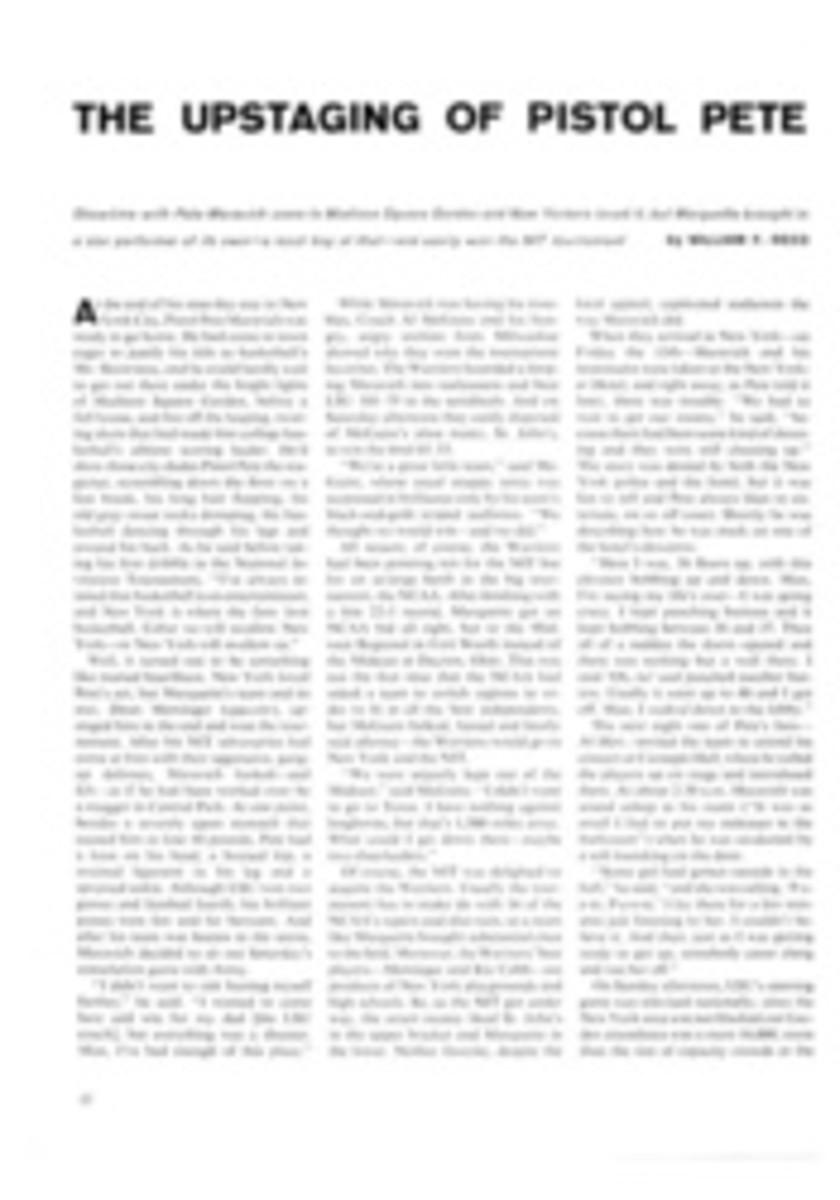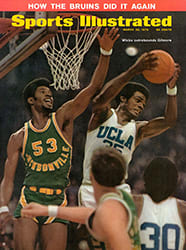
When the wind comes up, the doctor is absent
Observe the gray-haired man in the picture below. His name is Stuart Walker and he is sailing a cockleshell in a snowstorm. He is sailing on the Severn River near Annapolis. The water is very cold. The wind is very cold. Stuart Walker is very cold. He has his feet hooked under a toe strap so that he can sit outside the boat. The boat is wet. Stuart Walker's seat is wet. His stomach muscles hurt. His face is freezing. His fingers are stiff. Stuart Walker is very happy. The crewmen are not happy. They would like to go ashore and have a nice warm jolt of rum. The skipper will not let them go ashore. He will sail until he has extracted all the day can give in wind and wave, for he is the dilly-down-daffiest small-boat skipper in all the world.
Although in middle age and not much bigger than a bollard, Walker is also one of the world's best sailors. Many sailing people find this surprising, since Walker has more theories about sailing than a belfry has bats, and at times appears to be applying all of them simultaneously. As one dazzled rival has remarked, "I've heard him say things like the weather pattern over Baltimore today should interact with the pattern over Annapolis and, with an incoming tide and the birds on Greenbury Point singing one note off-key, the wind should favor the other shore."
Then there is this thing Walker has about gadgets. He is the Hammacher-Schlemmer of the seven seas. Gadgets sprout from his boats like toadstools from a soggy lawn. "I have seen him put five new gadgets on a boat," says a friend, "win a race and then go crazy trying to figure out which one did it."
Walker is an M.D. who teaches pediatrics at the University of Maryland and is head of the department of pediatrics at Mercy Hospital in Baltimore, but he has long since given up private practice in order to have more time for sailing, thinking about sailing, writing books and articles about sailing, lecturing on the subject of sailing and propagandizing heathen landlubbers on its myriad virtues. Occasionally he has time to ponder his own personality, and this has led him down curious byways. "I see myself as Charlie Brown pitching a baseball game in pouring rain," he says. "The field is flooded and nearly everyone has gone home except Charlie, who is up to his knees in water. Lucy says, 'He's an idiot, but you've got to admire him for it.' "
Men who have crewed for Walker would perhaps be reminded of Captain Bligh more poignantly than Charlie Brown, but there is truth in the up-to-his-knees-in-water image all right. Let's face it: when a winter northwester blows in, only mad gobs go sailing for fun on the Severn. Walker does it all the time. It was my dubious pleasure to be in his crew in a Soling sloop not long ago. As we gathered on the dock of the Annapolis Yacht Club, Walker was hatless. He wore a blue track suit with red, white and blue "U.S.A." lettering—a souvenir of Mexico's Olympics, in which he served as navigator and tactician aboard the 5.5-meter yacht Cadenza.
"A chicken, look," someone shouted derisively as a battered sloop, wearing only a scrap of mainsail in deference to the gale, came into view. Walker's response was to toss two more sail bags aboard the Soling. They were not conventional sail bags. They were "turtles," which contain spinnakers, sails meant for balmy days and silken breezes. One could picture the mast catapulting overboard, the decks awash, the boat foundering, then a swim in 40° water.
Anyway, up went the jib and main, and the Soling leaped away from the dock. She flew through water smoothed by the Naval Academy's great gray lee, then from the outer rim of sheltered water into the angry Severn, where whitecaps curled and foamed. As a bitter spray flayed our faces Walker steered and smiled and smiled and smiled.
Walker relinquished the helm momentarily to set up the spinnaker. It filled with a crack and almost instantly launched the sloop on a run that chiseled destroyer-sized waves at her bow and required Walker to steer magnificently against the boat's inclination to broach. (Afterward, a shorebound spectator said the sight of Walker surfing down the Severn was one of the wildest damned things he had ever witnessed.)
"Well," said Walker, when finally he steered for shore, "I guess we stayed on that last tack too long. My face is frozen. But that was fun, wasn't it?"
It should not surprise you that Walker, who sailed Q-boats and Stars on Long Island Sound in the '30s while earning his M.D., volunteered for the paratroops during World War II. He helped occupy Japan and finished out his military career as a divisional surgeon at Fort Bliss, Texas.
Soon Walker discovered Chesapeake Bay, started doctoring as a civilian and bought his first International Fourteen dinghy, Sea Duty, thereby beginning a long and passionate affair with that class of boat. In its small way the Fourteen is as sophisticated in hull and complicated in gear as an America's Cup 12-meter. Considerable latitude is given to designers. Some Fourteens are fat, some are thin. Some centerboards move back and forth and from side to side as well as up and down. Sails can change shape like magic at the tug of a cord. Yet different as one Fourteen may be from another, as a class they are unmistakable. "Without question," says Walker, "the Fourteen is the greatest centerboard boat in the world."
Walker's first crew in Sea Duty was his wife, Frances. "She was a great crew," he says, "but she was too incisive. She'd say, 'There's a wind shift over there,' but the wind shift never seemed to materialize. I got her out of the boat quick." Today Frances crews the Walker household.
The America's Cup of dinghy racing is Britain's Prince of Wales Trophy, but with national roles reversed. Until Walker won it in 1964 the host's grip on the trophy had been as tight as ours on that old mug in the New York Yacht Club.
Preliminary races during Prince of Wales week did not go well for Walker. In the last of these he fouled out almost before the race had begun. "Any other sailor," says Bruce Lee, an editor friend of Walker's, "would have gone ashore to belt a few." What Walker did was climb a cliff overlooking the racecourse at Lowestoft to study every yard of water. Then he visited the docks and pubs and grilled fisherfolk for local lore. Finally, he put all his findings on a chart.
This remarkable document provided for every contingency except the sanity of Walker's crew, George (Stovy) Brown, who not only had to cope with the usual array of gadgets but also was expected to play them like a concert pianist. Stripped to its essentials, Walker's master plan told him to hug the shore rather than follow the local practice, which was to look for the strongest winds farther out. Needless to say, the fleet headed out, Walker headed in and Walker won the race.
When he gets philosophical about racing, Walker writes things like, "There are many who, in sailing, are reminded of symbolic conflicts with 'father' or 'brother' and who, in an impasse between stimulated desire to defeat him and a guilty concern that they might, alternate between pressing on to victory and deliberate self-destruction."
Walker himself seems to have very little fear of winning, although one cannot be absolutely sure. There was this race for Fourteens in blustery winds on the Chesapeake in which Walker was so conspicuously the leader that he could have sculled the last downwind leg to the finish line. On rounding the buoy, however, Walker chose the opposite of a safety-first approach and hoisted his spinnaker. This was like driving a car with bald tires on glare ice. As Walker flew toward the line it occurred to him that he might have some difficulty getting the blasted kite down without capsizing. Over the line he went under full sail and on toward Baltimore until the wind subsided enough to tame the kite.
There is a stubborn streak in Walker, which he makes no attempt to conceal. "It is almost impossible to get him to give up, even when his boat is half gone," says St. John Martin, a Marylander who crewed for Walker before becoming a skipper himself. "In one race I sailed against him with the wind gusting to 40 knots. My boat capsized in a particularly vicious puff that simultaneously dismasted Walker." Dismasting is normally a pretty good excuse for quitting a race, but Walker had a bit of a stump left, on which he managed to hang a rag of sail. He limped around the course and finished the race. As a result he placed second in that series rather than third. "Of course," says Martin, "it was worth it to Walker."
Under Walker's guidance the Severn Sailing Association at Annapolis, once an outfit of no particular influence, has become the foremost small-boat sailing club in the U.S. "They asked me to save the association," Walker says with characteristic modesty, "so I saved it." Walker raised money, scouted a new site and goaded club members through weeks of do-it-yourself building to provide a clubhouse and other facilities.
Dr. and Mrs. Walker and their two daughters live not far away in a comfortable place overlooking Luce Creek. One room contains Walker's trophies, including an especially graceful one called the Severn Trophy. Walker executed it himself in stainless steel as a hobbyist and won it as a sailor.
By the way, if you should see a small, gray-haired man giving every evidence of trying to sail a small boat on the lawn of a comfortable house overlooking Luce Creek at Annapolis, do not call the nearest funny farm. That is just good old Stuart Walker tuning up one of his craft.
PHOTO
HIKING OUT ON A SOLING SLOOP, WALKER ENJOYS A TYPICALLY ACROBATIC RIDE

